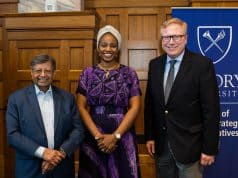Is the next Hulu, Microsoft or Facebook destined to be “made in India?”
Not so fast, according to a panel of business leaders who met recently to discuss “India’s Promise of Innovation.” First, India must streamline its bureaucracy, embrace inclusive growth and solidify a reputation for product innovation.
“It’s only a matter of time,” said Suraj Prakash, vice president for global delivery at Wipro. “They say in another five years IBM will be more Indian than most Indian companies.”
Transforming India’s challenges into opportunities was the theme of the second annual Emerging India Summit, “Crossing Borders,” held Feb. 24-25 at Goizueta Business School and Emory’s School of Law. Organized by the student-led Emerging India Forum, the Halle Institute and Goizueta and Emory College faculty, the summit convened scholars, diplomats, corporate leaders and medical experts to tackle India’s complexity on multiple fronts. Panels explored India’s comparative economic advantages and disadvantages, military strategies, market innovations and the future of Indo-U.S. relations.
George S. Craft Distinguished University Professor of Information Systems & Operations Management Benn Konsynski moderated the innovation panel, which examined innovation as a growth driver in consumer products, pharmaceuticals and the tech sector.
Suhas Apte, vice president for sustainability at Kimberly-Clark, discussed his company’s effort to expand the disposable diaper market in India through competitive pricing, production outsourcing and pediatrician buy-in. As a result, the market has grown 50 percent a year for the last five years, he said.
Similarly, India’s pharmaceutical industry has ballooned as more U.S.-based companies are relocating clinical trials to take advantage of India’s highly-skilled physicians and large patient population, explained Kumar Kantheti, director of market research at Shionogi Pharma Inc. and a Goizueta alum. India has the second-highest number of FDA-approved manufacturing sites behind the U.S., he added.
In the IT arena, Indians were among the first to drive workforce segmentation, Prakash said.
“The workforce development system in India is by far the best in the world,” added Vivek Wadhwa, distinguished visiting scholar at the Halle Institute and a columnist for Bloomberg Businessweek. The “magic of India,” he continued, is in the country’s ambitious middle-aged entrepreneurs. These workers are drawing on their years of experience at Western companies to fuel a “reverse brain drain” back to India, where they have established hundreds of thousands of startups.
That “can-do” attitude is a defining characteristic of the Indian people,” explained Prakash.
“The poorest man believes that his tomorrow will be better than today,” he said.
India’s Assets and Liabilities
In a separate discussion, Jagdish Sheth, Charles H. Kellstadt Professor of Marketing, outlined India’s resource advantages and legacy weaknesses as the country steadily achieves global integration both economically and politically.
India’s economic freedom, established in 1991, is relatively young compared to its 60-year-old political freedom, Sheth noted. The country has made impressive progress, however, becoming one of the fastest-growing economies in the world.
Equally important, the global image of India as a country of “roaming cows and snake charmers” has shifted to that of an emerging superpower with a vibrant middle class. By 2025, predicted Sheth, India will boast some of the largest global enterprises, particularly in basic industries such as copper and aluminum, gain significant geopolitical clout and may surpass U.S. consumer demand for mobile phones, appliances and agricultural products.
India’s comparative advantages are varied, explained Sheth:
- Demographics: By 2025, India will claim the largest pool of young educated workers in the world. China’s growth, by contrast, is expected to slow to less than five percent beyond 2025.
- Natural Resources: India is blessed with large fertile land, a vast coastal area of marine life and industrial raw materials like coal and iron ore.
- Indian Diaspora: A highly-educated work force, thriving in leadership roles around the globe, remains deeply committed to India.
- Diversity: India is more diverse than the European Union, yet its national identity remains strong.
Despite these advantages, India must overcome its national liabilities, Sheth continued:
- Fragmented Economy: The government must encourage industry consolidation by reforming the unorganized sector.
- Investment Gaps: India needs to prioritize modern infrastructure for value-added manufacturing by encouraging private investment. The country remains one of the poorest in the world on a per capita basis in its investment in education and health.
- Lax Enforcement: The government must promote a civic mindset, computerize records to root out corruption and abandon its historic mistrust of capitalism. “Rather than act as an enabler for its citizens, consumers, entrepreneurs and businesses to realize their potential,” Sheth said, “[the government] still acts as a gatekeeper, especially in attracting foreign direct investment.”
For more on the Emerging India Summit, click here.
– Margie Fishman










